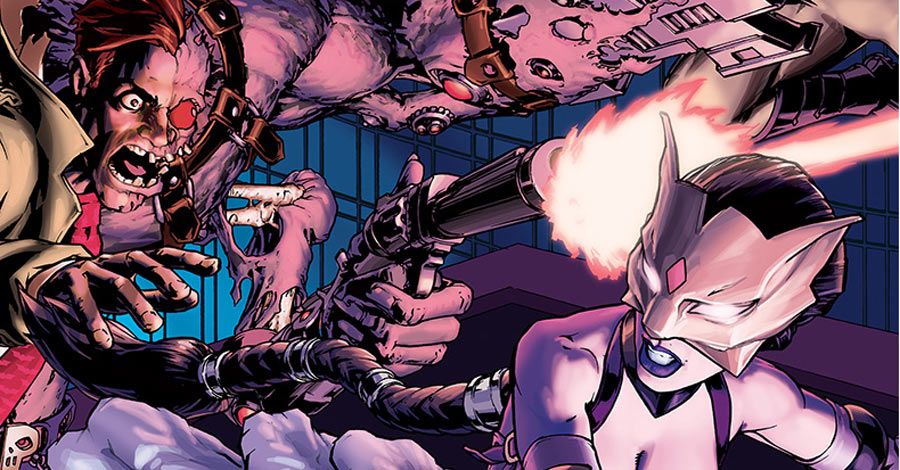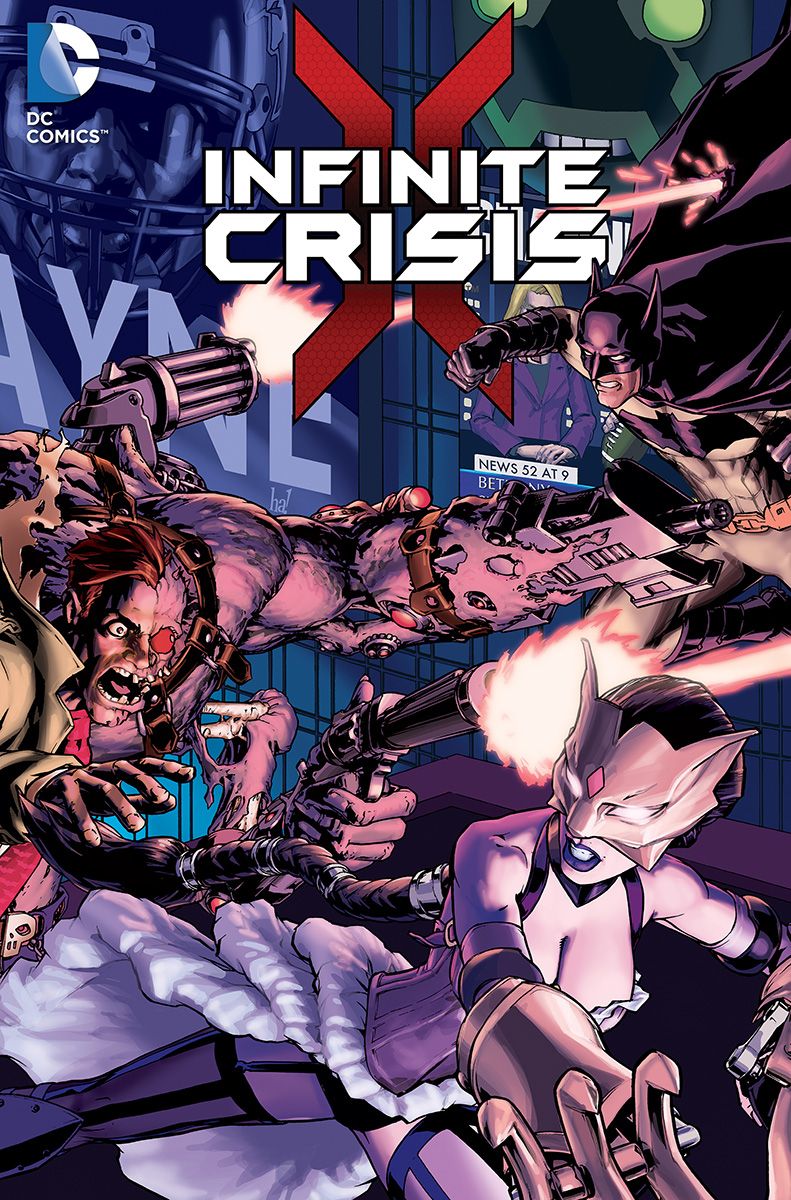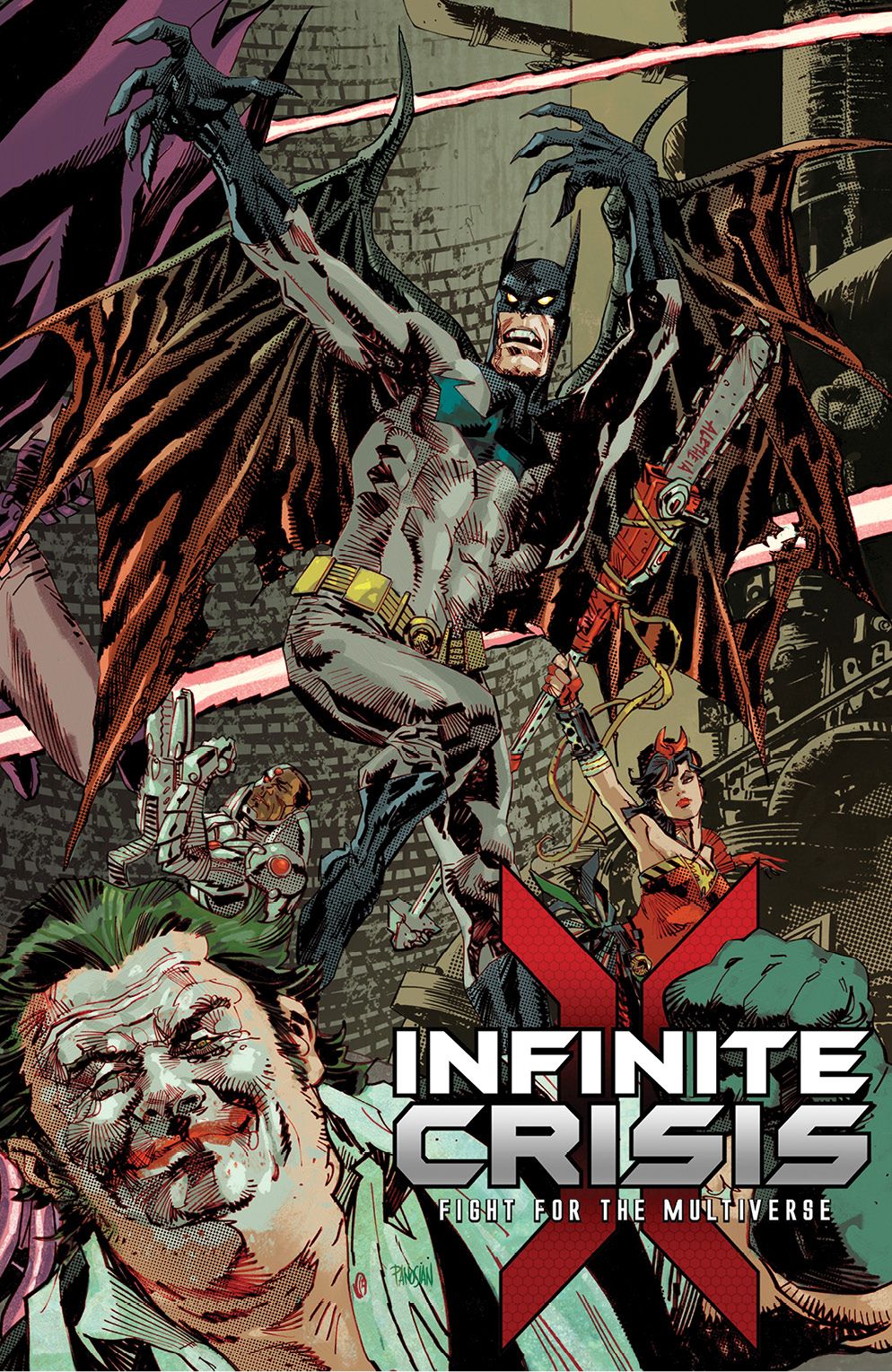Over the past few years, DC Entertainment's digital media-based comics have let fans revisit beloved TV shows and games, from the "Batman Beyond 2.0" continuation of the DC Animated Universe to the incredibly popular fighting game-based title, "Injustice: Gods Among Us." Now the company is looking to do the same with a brand-new digital series, "Infinite Crisis: Fight For The Multiverse," penned by writer Dan Abnett and based off the free-to-play multiplayer online battle arena (MOBA) game "Infinite Crisis."
RELATED: Blue Beetle Flies Into Battle In "Infinite Crisis"
Announced earlier this year, the comic boasts a rotating team of artists and will appear in a weekly digital format. Beginning with the exploits of Prime Earth Batman investigating an unusual crime, the comic takes off as he soon realizes there is more at stake, his sleuthing leading him to the door to the multiverse and the "Infinite Crisis" raging throughout. The series also engages in some game development of its own, introducing characters not yet playable and bringing myriad DC multiverses -- Atomic, Arcane, Mecha, Prime and Nightmare to name a few -- crashing together.
In advance of the comic's digital launch CBR spoke with Abnett about the series, the video game it's inspired by and his "Elseworlds" approach to "Infinite Crisis: Fight For The Multiverse."
CBR News: Dan, how do you approach working on a book that is tied-into another medium -- in this case, a video game?
Dan Abnett: A video game and also based on the original comic, there's three layers! [Laughs] With the video game, it really was a matter of comprehensively reading extensive information from the game developers to find out not only the premise of the game but the premise of the world and worlds they were basing it on, and also what the play experience is like. I'm not writing a comic that directly reflects the play experience, but if you play the game you understand the context of why characters are working the way they're working. It sort of fictionalizes that. So I have that as reference material -- but it was really a matter of talking to the game designers and trying to figure out what their desire was and what they were trying to achieve, and then translating that into comic form.
Like you said, the book is almost three-levels deep as its based on a video game based on the multiverse concept of "Infinite Crisis." What is the tone of the new comics and what premise launches your story?
Well I hope it's got the epic, sweeping tone that would be appropriate for a great big "Crisis" event, which is retroactively the backing of DC's mythology down the years. I'm trying to write it as it involves a -- I guess it's a bit more like a New 52 book in such as, right now, it's contemporaneous, but with a touch of the classic overtones of the original event as best I can.
RELATED: DC's "Infinite Crisis" Game Mines Multiverse For Roster
Then how closely does what you're doing dovetail into the video game? Are they two very different stories or does this happen within the world of the video game?
It's a little of both, to be honest. I'm sort of writing it as a way of introducing people to the game itself; you can read this and go on into the game and there would be a sense of continuity, that you'd credibly believe this story has happened and then you start playing the game. But in another respect what I'm doing is playing the game in one particular version. I'm showing a possible iteration the way the game could be played by combining different characters and going to different worlds and setting different things up. And there is cross-pollination because as much as I'm taking characters they're creating, I'm also, with their permission, creating characters that are going back into the game. So some of the characters I've been thinking of developing, we said that we're working them out and they [the game developers] said, "Well we haven't gotten there yet, what do you want to do?" We've done it, and then they develop the character. That's quite nice, there's a nice meshing of these two things.
Are there any upcoming characters from this process you can talk about?
Well the first one we did is we wanted a nice villain in the opening section of the story. I suggested doing an Atomic version of Two-Face, which they had thought of but they said, "We hadn't got that far yet." So I sort of wrote a few things about what I would like to do and then they showed me visuals, and those all came together. It was something they were going to develop but I sort of accelerated that process by deciding to put him into the opening of the arc, as it were. And that was great fun because it's lovely to see the character brought to life as he would be in the game, and then be able to have the feedback for the plot of the story.
It seems interesting that with "Infinite Crisis," you're getting to almost influence the game and characters appearing in it -- you've done a lot of different work-for-hire stuff before, but is this experience different or more collaborative than other projects you've worked on for DC or other companies?
Yes, it is in a way because it gets to add an extra level to it. I mean, when you get to write for DC and the DC Universe, you're already playing with some of the best toys in the world. There's an opportunity to look at them and think, "What can I do with them that's different without, I suppose, breaking the toys -- how can I contribute to the ongoing mythology of this?"
With this we got essentially an extra creative force in the process, which is developing things in the particular light of playability and visual impact on the screen. So it's like almost what we did with Two-Face, because we are combining the experience of DC Comics and the experience of playing a very sort of explosive, visceral, exciting game. I wanted a sort of -- not loosely, but wandering interconnected storyline that reflects the sense of different people playing it, coming together and playing alongside each other, that kind of stuff. I hope that bit comes across, but it's very rewarding to have that third party contributing ideas and actually either coming in with brilliant ideas or being excited and inspired by something. They'll ask the questions I haven't thought of and present their feedback, so it's been very, very rewarding!
Discussing digital comics, I would be remiss if I didn't mention Tom Taylor's immensely popular "Injustice: Gods Among Us" digital-first series. As someone now writing a second digital tie-in to a video game, does the popularity of what DC's done before with "Injustice" influence the way you approach this, or change the way you view this comic?
I've certainly got a wonderful pattern to follow, because as you said, being remarkably successful as a tie-in comic I think it's inspired me as much as it shows this thing can be very, very popular. And also it shows you can do something that started as a tie-in, yet it stands alone legitimately as a DC comic in its own right. It's great if you combine the two if you're a game player and a comic reader, but if you're just a comic reader it should provide completely full entertainment value of itself. But yes, "Injustice" is fantastic and I hope we're as fun as that too, I hope people enjoy it as much!
As a reader, it feels like a lot of the digital titles, especially "Injustice," are like the DC "Elseworlds" titles that were self-contained and off continuity. Is that something you keep in mind as you write "Fight For The Multiverse?"
Yes, absolutely! In fact that's as important, if not more important, than the relationship to "Infinite Crisis" and other classic books. I want that kind of scope, but thinking about it in terms of "Elseworlds" books -- some of which I wrote back in the '90s! -- it feels with each world I go to, with each alternative character I come to, I try and think about what it would be like to write that character on their own, in an "Elseworlds" story to get the measure of them as a character on their own. Then informed by that character, place them into context of everything else that's going on, because almost every episode is a wonderful mix of different worlds and different characters. It's as much of the case of Prime Batman meets Atomic Wonder Woman because that's interesting -- but the way their expectations of each other and the expectations of the Wonder Woman or Batman that they know can be confounded or given major insight is really good fun! So "Elseworlds" is there, very much so, and I think quite deliberately. It's not the first Elseworld we go to -- it's not the first alternate world we go to -- but the setting for part of the first main arc is Gaslight Gotham. That was a deliberate nod to the fact that there is an Elsewhere book, "Gotham By Gaslight," because I wanted that sense of starting off in the most iconic place.
You mention Gaslight Gotham -- do you have a favorite universe to write in or a favorite alternate character you've been working on?
Yes -- if you had come to me several months ago I would have said Gaslight, and if you had talked to me a month ago I would have said, actually it's Atomic. If you're asking me this today I'll say, "Well I'm really enjoying Mecha!" [Laughs] As it comes to each one and I explore them, discover their possibilities, each one becomes a new favorite. I'm looking forward to switching back the stuff in Arcane that has been hinted at and I can move back to set up. I sort of set up one main story thread and then a few episodes in they run parallel, there's an ultimatum and they cross into each other, which I think reflects the multiplayer experience of the game. That is great fun, getting the measure of the thing. I wasn't sure exactly, for instance, what I could do with the Atomic world, and then I discovered because the entire world and fabric of it is open I could create stuff and there could be wonderful sidelong mentions of things.
As far as favorite characters are concerned, they've all been fun but the two that stand out to me so far, in terms of the alternates, is Arcane Green Lantern. He's sort of magnificent and enormously noble, I warmed to him as a character very much. There's a sort of naïvete to him because he comes from a less technological world, but he's incredibly honest and pure, which is nice. And then at the other end of the spectrum, I quickly knew to begin with I wanted a Nightmare character in there, so I chose Nightmare Robin who is just so feisty and difficult and immediately springs to mind because I paired him with Prime Batman. It's a growing double act because they really don't get on! [Laughs] Batman wants to treat him like Robin, and Robin doesn't want to be treated that way by anybody! So there's sort of a friction, but growing mutual respect -- Robin started off with zero respect for Prime Batman because he's un-powered and apparently a simplified version of the Batman he understands. A sort of growing, grudging respect begins to form. It's that sort of thing, where you put in a character because you think he's interesting but he springs to life and shows you the possibilities of how he'll clash and interact with other characters.
Talking about the visual physicality of how these worlds interact, the solicits lists Carl Potts, Szymon Kudranksi and others as artists. So does this mean each universe will have it's own artist, or will you have rotating artists coming in on the book for various arcs and issues?
A little bit of both. My editor has very cleverly eased the stress of delivering weekly episodes, which obviously is quite a big output as there's quite a lot to be done, especially by the artists, by structuring this wherever possible to put one artist on Gaslight, another artist on Atomic, and to move through that. Where possible what I've done is structure the story, without interrupting or spoiling the story, so we can have two episodes on one world with one artist and then move to another world with a different artist in order for the first artist to overtake and get ahead on the next bit. On some of these I deliberately structured the storyline so we move between places so the various art styles don't mingle, you don't have the person you associate with the Arcane world drawing Gaslight and that looks odd because that's not what you expect to see. I have to say the art I've seen has been absolutely jaw-droppingly lovely; I'm quite astonished by some of the things that have come in!
You mention it will be weekly -- will there be an endpoint to this or will this be like "Batman Beyond 2.0" and other digital comics where "Infinite Crisis: Fight For The Multiverse" will keep going as long as you want to write stories in these worlds?
Well again it's a little bit of both -- we have a sort of temporary file on planning story arcs that build to a big conclusion, so if the book does come to an end we have a really big, satisfying conclusion. If the book is as successful as we hope it will be and therefore becomes ongoing -- and we're hopefully planning for it to be! -- that would be the ending of the first major arc, and then we move ahead and do things from there. So right at the moment there is quite a lot of story to tell and almost infinite possibilities -- I don't believe I actually said that out loud, but there you go! [Laughter]
"Infinite Crisis: Fight For The Multiverse" will be available through comiXology and the DC Comics App.



